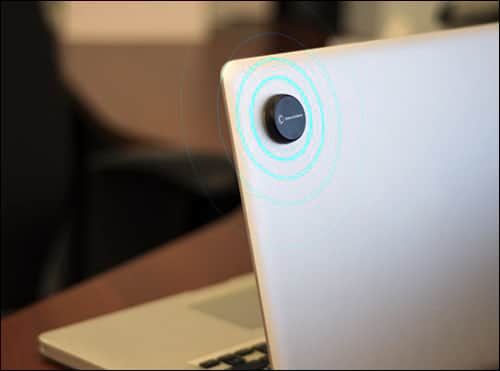Bluvision has released a new beacon product known as the BEEKs Mini Tamper Proof Tag that is small, relatively low in cost and designed to issue an alert in the event that anyone attempts to remove it from the item to which it is attached. Bluvision created the new product to bring beacon technology to users who might require a lower-cost or tamper-evident solution. Initial buyers, the company reports, plan to use the system to protect high-value assets in offices, warehouses and armories.
Bluvision, HID Global's beacon-based Internet of Things (IoT) division, provides real-time location system (RTLS) solutions using Bluetooth Low Energy (BLE) technology. The new product, released this month, is the first of its kind: a Bluetooth beacon that is tamper-proof, says John Sailer, the company's COO. Bluvision released the product at RFID Journal LIVE! Europe 2017, held last week in London, England.
Until now, there was little way for companies to ensure that beacons were not tampered with. If someone were to remove a beacon from an asset or location, he or she could potentially walk away with the very asset that a BLE system was designed to manage or protect. In some cases, the perpetrator could simply use a cutting device as basic as a fishing line to sever the adhesive connection between the asset and the beacon. This vulnerability on the part of the beacons created obstacles for companies and agencies that wanted to track such items as high-value assets at military installations or electronics in an office environment or in a supply chain.

In response, Bluvision reports, the firm built its smallest device using conductive technology. The company declined to describe how the technology works. Its Bluzone cloud-based software detects that change in the transmission and issues an alert indicating that the specific beacon is being removed or otherwise tampered with.
"Our entire solution is based on policies and alerts," Sailer says. The BluFi gateway, plugged into an outlet and receiving BLE transmissions, forwards the data to the Bluzone software via a Wi-Fi connection. If the software detects an alteration or does not detect a beacon at all, it follows the predetermined protocol to send alerts or store data.
"The whole premise," Sailer explains, "is that you define the alert parameters." So if a user wanted managers to receive alerts only if a beacon moved at specific times and locations, they could direct the system accordingly. The solution, for example, can be programmed to send tamper alerts to one official, and other data (such as beacons' movements) to another individual.
According to the company, the BEEKs Mini is about the size of two quarters stacked one on top of the other. This small form-factor enables it to be attached to mobile items, such as a laptop computer, a tablet or smaller-sized, specialized assets. It can also be mounted on high-value items, Sailer notes, including tools, electronics or medical equipment.
The tamper-evident device includes a built-in beacon transmitter, while it can also be purchased with an accelerometer and a temperature monitor. Therefore, multiple versions of the tag are available—with either or both of the sensors, and in the two sizes. The price, based on the size and the sensors chosen, varies from $8 to $12 per tag, while beacons can typically average $20 to $24 apiece.
Because the BEEKs Mini is smaller than the other products in Bluvision's portfolio, it is also less expensive, with less hardware built into it, such as a smaller housing and battery. One compromise the technology company has had to make is in power storage; because it uses a smaller battery, the life expectancy of that battery is approximately three years, as opposed to about five years for the larger version. There is also a beacon with a 10-year battery life. Bluvision has already sold thousands of the new beacons, Sailer reports, and expects large installations using the tags to take place—including a deployment by at least one international military agency—by the first quarter of 2018.